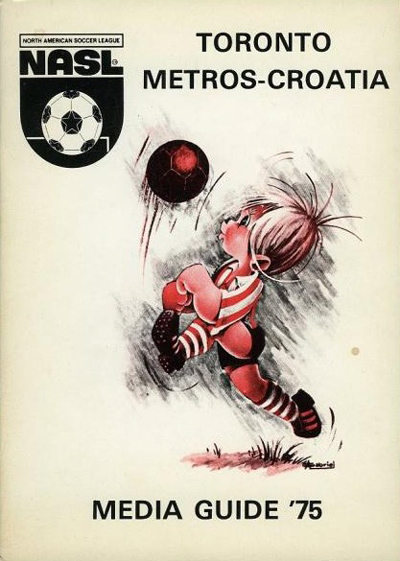North American Soccer League (1975-1978)
Tombstone
Born: 1975 – The Toronto Metros merge with Toronto Croatia
Re-Branded: February 1, 1979 (Toronto Blizzard)
First Game:
Last Game:
Soccer Bowl Champions: 1976
Stadia
1975-1978: Varsity Stadium (22,000)11978 North American Soccer League Guide
Opened: 1911
1976: Lamport Stadium
Opened: 1975
Marketng
Team Colors: Red, White & Blue21978 North American Soccer League Guide
Ownership
Owners: Sam Paric, et al.
Background
Toronto Metros-Croatia was an anomaly within the North American Soccer League during the NASL’s boom years of the mid-to-late 1970’s. The club emerged in 1975 from the merger of the NASL’s financially strapped Toronto Metros (1971-1974) and Toronto Croatia of Canada’s small-time National Soccer League.
To the chagrin of league executives and observers, the merged club played up its ethnic identity, coming up with the awkward “Metros-Croatia” moniker and filling its management (entirely) and roster (largely) with ethnic Croats.
Criticism
In 1977, Tampa Bay Rowdies beat writer Ken Blankenship from The St. Petersburg Times published a long screed against the Metros-Croatia organization (and, by extension, the NASL for tolerating the club). Blankenship’s hackles were raised by a miserable experience trying to cover a Rowdies road game in Toronto. The writer described the Metros-Croatia as essentially an insular “neighborhood soccer team” lacking the most basic professional standards of operation and promotion, and existing solely for the amusement of a tiny bad of expatriate supporters: owner “Sam <Paric> and his Yugoslavian pals”.
Blankenship wasn’t a lone voice in the wilderness either. League officials purportedly directed broadcasters of the 1976 Soccer Bowl to refer to the club only as “Toronto”. At 1976 NASL meetings held during the Soccer Bowl championship in Seattle, influential New York Cosmos President Clive Toye introduced a motion to ban “ethnic names” from the 20-team league – a pointed jab at Toronto. The Croatians who backed the team pointed out that their name (and their money) was good enough for the NASL when they stepped in to bail out the failing Metros franchise in 1975.
1976 Soccer Bowl Championship
But whatever Metros-Croatia lacked in professionalism off the field, they were a competitive club. Despite a chaotic 1976 season that featured a seven-game scoreless streak, the mid-season sacking of autocratic coach Ivan Markovic, and constant financial problems, Metros-Croatia started to click at the right time. The club rode a late season hot streak to claim the 1976 Soccer Bowl championship of the NASL, defeating the Minnesota Kicks 3-0 at the Seattle Kingdome on August 28, 1976.
Although the club was typically labelled a “Croatian” or “Yugoslav” club, Metros-Croatia’s 1976 Soccer Bowl run was powered by the mid-season acquisition of Portuguese legend Eusebio and German midfielder Wolfgang Sunholz from the NASL’s financially distressed Boston Minutemen franchise. Eusebio led Metros-Croatia in scoring and placed eighth overall in the NASL in 1976, but was left off the league’s All-Star team, as were all other members of the championship Toronto side. Eusebio also scored the decisive first goal in the Soccer Bowl ’76 final against Minnesota.
Sale & Re-Branding
After the 1976 season, cash-strapped Metros-Croatia couldn’t afford to re-sign Eusebio or Sunholz. Clive Toye’s move to ban ethnic names went nowhere. The rest of the NASL had to deal with the odd little Croatian club from Ontario for two more seasons.
Finally in January 1979 the club’s backers sold out to Global Television Network, who re-branded the team as the Toronto Blizzard a month later. Under Global, the Blizzard also left Metros-Croatia’s humble home at the University of Toronto and moved into new giant modern Exhibition Stadium for the 1979 season. Toronto Croatia re-joined the semi-pro National Soccer League.
History-minded fans of modern day Major League Soccer may see many parallels between the Toronto Metros-Croatia story and the controversial ethnic identity and employment practices of MLS’ former Chivas USA club in Los Angeles.
Toronto Metros-Croatia Shop
Editor's Pick
Rock n' Roll Soccer
The Short Life and Fast Times of the North American Soccer League
by Ian Plenderleith
The North American Soccer League – at its peak in the late 1970s – presented soccer as performance, played by men with a bent for flair, hair and glamour. More than just Pelé and the New York Cosmos, it lured the biggest names of the world game like Johan Cruyff, Franz Beckenbauer, Eusebio, Gerd Müller and George Best to play the sport as it was meant to be played-without inhibition, to please the fans.
The first complete look at the ambitious, star-studded NASL, Rock ‘n’ Roll Soccer reveals how this precursor to modern soccer laid the foundations for the sport’s tremendous popularity in America today.
When you make a purchase through an affiliate link like this one, Fun While It Lasted earns a commission at no additional cost to you. Thanks for your support!
Toronto Metros-Croatia Video
2010 CBC featurette on Metros-Croatia (2:09)
Soccer Bowl ’76 Highlights Film. Metros Croatia vs. Minnesota Kicks at the Seattle Kingdome.
In Memoriam
Midfielder Wolfgang Sunholz (Metros-Croatia ’76) passed away at the age of 73 on December 29th, 2019. Front Row Soccer remembrance.
Downloads
6-16-1976 Metros-Croatia vs. New York Cosmos Media Kit
6-16-1976 Toronto Metros-Croatia vs New York Cosmos Game Notes
Links
“Historicist: Toronto-Metros-Croatia, 1976 Soccer Bowl Champions“, Jamie Bradburn, Torontoist, September 24, 2016
###




